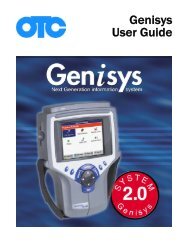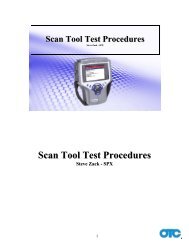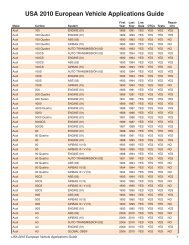ABS / AIR BAG 2004 USER GUIDE - OTC
ABS / AIR BAG 2004 USER GUIDE - OTC
ABS / AIR BAG 2004 USER GUIDE - OTC
Create successful ePaper yourself
Turn your PDF publications into a flip-book with our unique Google optimized e-Paper software.
<strong>ABS</strong> / Air Bag <strong>2004</strong> User Guide Chapter 3: Datastream<br />
About Datastream<br />
3: Datastream<br />
The Datastream function lets you view live <strong>ABS</strong><br />
and air bag data from a vehicle’s electronic control<br />
unit (ECU). This chapter describes how to use the<br />
Data-stream function.<br />
About Datastream<br />
Datastream is the communication of information<br />
between the sensors, computer, and actuators<br />
(switches) on a vehicle. The sensors monitor the vehicle<br />
systems and send data to the vehicle computer, the<br />
computer uses the data from the sensors to determine<br />
if any vehicle systems need adjusting. If so, the computer<br />
converts the data into commands and sends the<br />
commands to the actuators. The actuators then convert<br />
the commands to mechanical actions that adjust the<br />
vehicle systems.<br />
As this stream of data is being communicated in the<br />
vehicle, the software can read the vehicle computer<br />
and display the data information in a readable format,<br />
called datastream. This lets you view “live” sensor and<br />
switch readings.<br />
Automatic Diagnostic Code<br />
Triggered Record<br />
The <strong>ABS</strong> Air Bag <strong>2004</strong> software has an automatic Diagnostic<br />
Code Triggered Record function.This function<br />
works automatically and does not appear as an option<br />
on any menu. If a diagnostic fault occurs while you are<br />
testing a vehicle, the software automatically creates a<br />
recording for playback and alerts you with a screen<br />
message. To replay these recordings, refer to “Playback<br />
a Data File” on page 21.<br />
Basic Datastream Procedure<br />
Use the following steps to obtain a basic understanding<br />
of how the Datastream function works.<br />
Note: Before performing this procedure, follow the instructions<br />
in “Chapter 2: Start-up Steps” on page 13.<br />
To use the datastream function, follow these steps:<br />
Note: Optionally, you can use Custom Datastream and<br />
select specific datastream items for viewing. For details,<br />
refer to “Chapter 4: Custom Datastream” on page 31.<br />
Figure 3.1: Diagnostic Menu Screen<br />
1 From the Diagnostic Menu screen, select Datastream<br />
and press the ENTER key. This displays the Datastream<br />
screen (see Figure 3.2 on page 20).<br />
Note: If a group selection screen appears, select a group<br />
and press the ENTER key to display the Datastream<br />
screen.<br />
19






